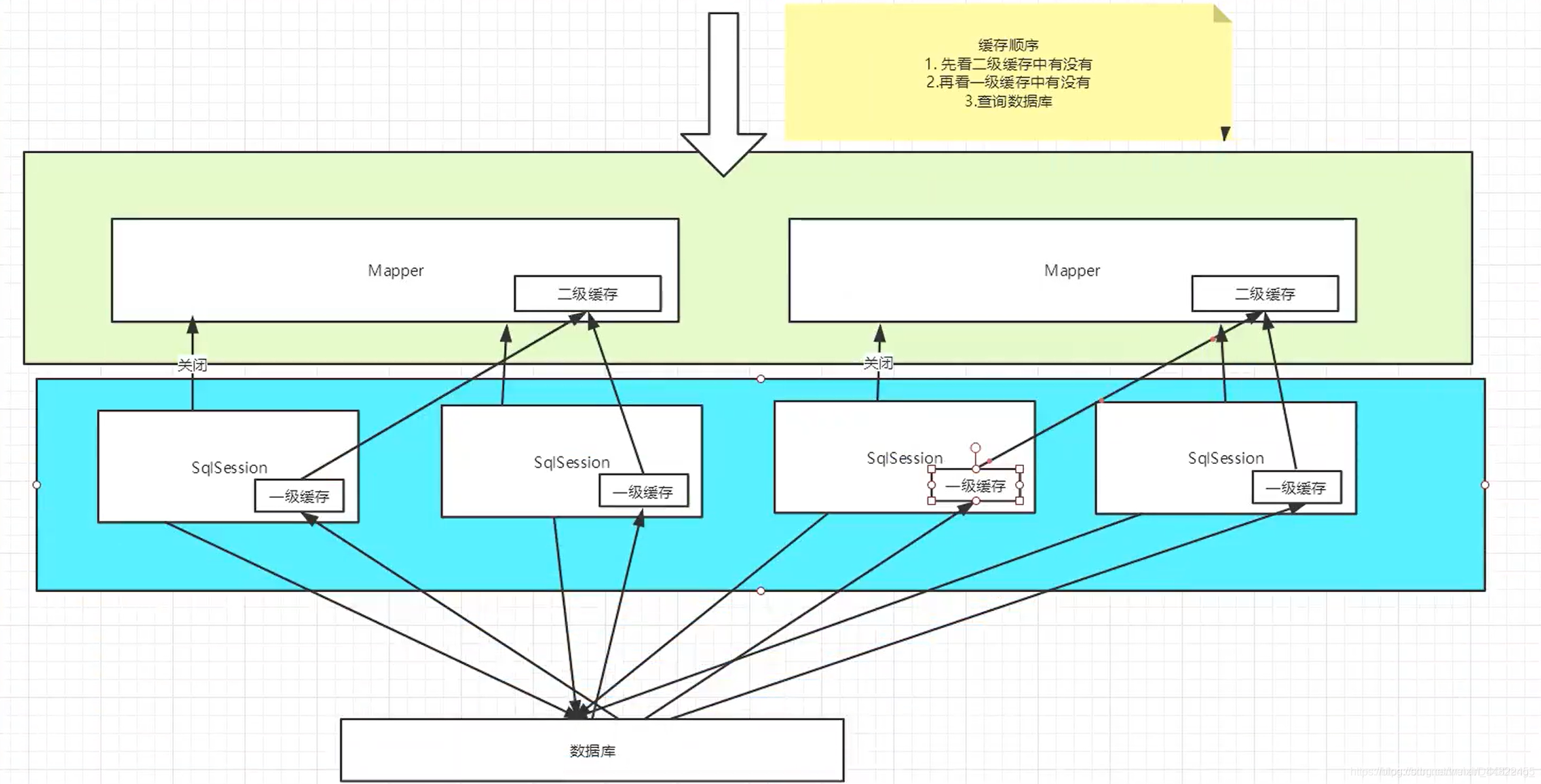Mybatis入门(二)
1. 多对一处理(多个学生一个老师)
1.1 按照查询嵌套处理
<!--
思路:
1. 查询所有的学生信息
2. 根据查询出来的学生的tid寻找特定的老师 (子查询)
-->
<select id="getStudentInfo" resultMap="StudentTeacher">
select * from student
</select>
<resultMap id="StudentTeacher" type="Student">
<result property="id" column="id"/>
<result property="name" column="name"/>
<!--对象使用assiociation-->
<!--集合用collection-->
<association property="teacher" column="tid" javaType="Teacher" select="getTeacher"/>
</resultMap>
<select id="getTeacher" resultType="Teacher">
select * from teacher where id = #{id}
</select>
1.2 按照结果嵌套处理(推荐)
<!--按照结果嵌套处理-->
<select id="getStudentInfo2" resultMap="StudentTeacher2">
select s.id sid,s.name sname,t.name tname
from student s,teacher t
where s.tid = t.id;
</select>
<resultMap id="StudentTeacher2" type="Student">
<result property="id" column="sid"/>
<result property="name" column="sname"/>
<association property="teacher" column="Teacher">
<result property="name" column="tname"/>
</association>
</resultMap>
-
子查询 (按照查询嵌套)
-
联表查询 (按照结果嵌套)
2. 一对多处理(一个老师拥有多个学生)
2.1 实体类
@Data
public class Student {
private int id;
private String name;
private int tid;
}
@Data
public class Teacher {
private int id;
private String name;
//一个老师拥有多个学生
private List<Student> students;
}
2.2 按照结果嵌套嵌套处理
<!--按结果嵌套查询-->
<select id="getTeacher" resultMap="StudentTeacher">
SELECT s.id sid, s.name sname,t.name tname,t.id tid FROM student s, teacher t
WHERE s.tid = t.id AND tid = #{tid}
</select>
<resultMap id="StudentTeacher" type="Teacher">
<result property="id" column="tid"/>
<result property="name" column="tname"/>
<!--复杂的属性,我们需要单独处理 对象:association 集合:collection
javaType=""指定属性的类型!
集合中的泛型信息,我们使用ofType获取
-->
<collection property="students" ofType="Student">
<result property="id" column="sid"/>
<result property="name" column="sname"/>
<result property="tid" column="tid"/>
</collection>
</resultMap>
2.3 按照查询嵌套处理
<!--按照查询嵌套处理-->
<select id="getTeacher2" resultMap="TeacherStudent2">
select * from mybatis.teacher where id = #{id}
</select>
<resultMap id="TeacherStudent2" type="com.qi.pojo.Teacher">
<collection property="studentList" column="id" javaType="ArrayList"
ofType="com.qi.pojo.Student"
select="getStudentByTeacherId"></collection>
</resultMap>
<select id="getStudentByTeacherId" resultType="com.qi.pojo.Student">
select * from mybatis.student where tid = #{id}
</select>
小结
-
关联 - association 【多对一】
-
集合 - collection 【一对多】
-
javaType & ofType
- JavaType用来指定实体类中的类型
- ofType用来指定映射到List或者集合中的pojo类型,泛型中的约束类型
注意点:
-
保证SQL的可读性,尽量保证通俗易懂
-
注意一对多和多对一,属性名和字段的问题
-
如果问题不好排查错误,可以使用日志,建议使用Log4j
面试高频
-
Mysql引擎
-
InnoDB底层原理
-
索引
-
索引优化
3. 动态SQL
-
什么是动态SQL:动态SQL就是根据不同的条件生成不同的SQL语句
-
所谓的动态SQL,本质上还是SQL语句,只是我们可以在SQL层面,去执行一个逻辑代码
-
动态SQL就是在拼接SQL语句,我们只要保证SQL的正确性,按照SQL的格式,去排列组合就可以了
建议:先在Mysql中写出完整的SQL,再对应的去修改成我们的动态SQL实现通用即可
3.1 搭建测试环境
- 创建博客表
create table `blog`(
`id` varchar(50) not null comment '博客id',
`title` varchar(100) not null comment '博客标题',
`author` varchar(30) not null comment '博客作者',
`create_time` datetime not null comment '创建时间',
`views` int(30) not null comment '浏览量'
)ENGINE=InnoDB DEFAULT CHARSET=utf8
- 实体类
@Data
public class Blog {
private int id;
private String title;
private String author;
private Date createTime;// 属性名和字段名不一致
private int views;
}
- 驼峰命名转换
<settings>
<setting name="mapUnderscoreToCamelCase" value="true"/>
</settings>
- 插入测试数据
<?xml version="1.0" encoding="UTF-8" ?>
<!DOCTYPE mapper
PUBLIC "-//mybatis.org//DTD Config 3.0//EN"
"http://mybatis.org/dtd/mybatis-3-mapper.dtd">
<mapper namespace="com.qi.mapper.BlogMapper">
<insert id="addBlog" parameterType="Blog">
insert into mybatis.blog (id, title, author, create_time, views) values
(#{id}, #{title}, #{author}, #{create_time}, #{views});
</insert>
</mapper>
test
@Test
public void addBlog(){
SqlSession sqlSession = MybatisUtils.getSqlSession();
BlogMapper blogMapper = sqlSession.getMapper(BlogMapper.class);
Blog blog = new Blog();
blog.setId(IDUtils.getId());
blog.setAuthor("超超子");
blog.setCreateTime(new Date());
blog.setViews(999);
blog.setTitle("first");
blogMapper.addBlog(blog);
blog.setId(IDUtils.getId());
blog.setTitle("second");
blogMapper.addBlog(blog);
blog.setId(IDUtils.getId());
blog.setTitle("third");
blogMapper.addBlog(blog);
blog.setId(IDUtils.getId());
blog.setTitle("forth");
blogMapper.addBlog(blog);
sqlSession.close();
}
3.2 if
<select id="queryBlogIF" parameterType="map" resultType="blog">
select * from mybatis.blog
<where>
<if test="title != null">
and title = #{title}
</if>
<if test="author != author">
and author = #{author}
</if>
</where>
</select>
test
@Test
public void queryBlogIF() {
SqlSession sqlSession = MybatisUtils.getSqlSession();
BlogMapper blogMapper = sqlSession.getMapper(BlogMapper.class);
Map map = new HashMap();
map.put("title", "second");
List<Blog> list = blogMapper.queryBlogIF(map);
for (Blog blog : list) {
System.out.println(blog);
}
sqlSession.close();
}
3.3 choose、when、otherwise
<select id="queryBlogchoose" parameterType="map" resultType="Blog">
select * from mybatis.blog
<where>
<choose>
<when test="title != null">
title = #{title}
</when>
<when test="author != null">
and author = #{author}
</when>
<otherwise>
and views = #{views}
</otherwise>
</choose>
</where>
</select>
3.4 trim、where、set
<update id="updateBlog" parameterType="map">
update mybatis.blog
<set>
<if test="title != null">
title = #{title},
</if>
<if test="author != null">
author = #{author}
</if>
</set>
where id = #{id}
</update>
3.5 SQL片段
-
使用sql便签抽取公共部分
-
在使用的地方使用include标签
<!--实现代码复用-->
<sql id="if-title-author">
<if test="title != null">
title = #{title}
</if>
<if test="author != null">
and author = #{author}
</if>
</sql>
<select id="queryBlogIF" parameterType="map" resultType="Blog">
select * from mybatis.blog
<where>
<include refid="if-title-author"></include>
</where>
</select>
注意:
-
最好基于单表
-
sql里不要存在where标签
3.6 for-each
<!--
ids是传的,#{id}是遍历的
select * from mybatis.blog where 1=1 and (id=1 or ad=2 or id=3)
-->
<select id="queryBlogForeach" parameterType="map" resultType="blog">
select * from mybatis.blog
<where>
<foreach collection="ids" item="id" open="and ("
close=")" separator="or">
id=#{id}
</foreach>
</where>
</select>
test-foreach
@Test
public void queryBlogForeach(){
SqlSession sqlSession = MybatisUtils.getSqlSession();
BlogMapper blogMapper = sqlSession.getMapper(BlogMapper.class);
Map map = new HashMap();
ArrayList<Integer> ids = new ArrayList<Integer>();
ids.add(1);
ids.add(3);
map.put("ids",ids);
List<Blog> list = blogMapper.queryBlogForeach(map);
for (Blog blog : list) {
System.out.println(blog);
}
sqlSession.close();
}
4. 缓存(了解)
4.1 简介
- 什么是缓存[Cache]?
-
存在内存中的临时数据
-
将用户经常查询的数据放在缓存(内存)中,用户去查询数据就不用从磁盘上(关系型数据库文件)查询,从缓存中查询,从而提高查询效率,解决了高并发系统的性能问题
- 为什么使用缓存?
减少和数据库的交互次数,减少系统开销,提高系统效率
- 什么样的数据可以使用缓存?
经常查询并且不经常改变的数据 【可以使用缓存】
4.2 MyBatis缓存
MyBatis系统中默认定义了两级缓存:一级缓存和二级缓存
-
默认情况下,只有一级缓存开启(SqlSession级别的缓存,也称为本地缓存)
-
二级缓存需要手动开启和配置,他是基于namespace级别的缓存。
-
为了提高可扩展性,MyBatis定义了缓存接口Cache。我们可以通过实现Cache接口来定义二级缓存。
4.3 一级缓存
一级缓存也叫本地缓存:SqlSession
-
与数据库同一次会话期间查询到的数据会放在本地缓存中
-
以后如果需要获取相同的数据,直接从缓存中拿,没必要再去查询数据库
缓存失效的情况:
-
查询不同的东西
-
增删改操作,可能会改变原来的数据,所以必定会刷新缓存
-
查询不同的Mapper.xml
-
手动清理缓存:
sqlSession.clearCache();
4.4 二级缓存
基于namespace级别的缓存,一个名称空间,对应一个二级缓存
工作机制
-
一个会话查询一条数据,这个数据就会被放在当前会话的一级缓存中
-
如果会话关闭了,这个会话对应的一级缓存就没了;但是我们想要的是,会话关闭了,一级缓存中的数据被保存到二级缓存中
-
新的会话查询信息,就可以从二级缓存中获取内容
-
不同的mapper查询出的数据会放在自己对应的缓存(map)中
步骤:
1.开启全局缓存
<!--显示的开启全局缓存-->
<setting name="cacheEnabled" value="true"/>
- 在Mapper.xml中使用缓存
<!--在当前Mapper.xml中使用二级缓存-->
<cache
eviction="FIFO"
flushInterval="60000"
size="512"
readOnly="true"/>
小结
-
只要开启了二级缓存,在同一个Mapper下就有效
-
所有的数据都会放在一级缓存中
-
只有当前会话提交,或者关闭的时候,才会提交到二级缓存中
4.5 缓存原理

4.6 自定义缓存-ehcache(了解即可)
Ehcache是一种广泛使用的开源Java分布式缓存。主要面向通用缓存
- 导包
<!-- https://mvnrepository.com/artifact/org.mybatis.caches/mybatis-ehcache -->
<dependency>
<groupId>org.mybatis.caches</groupId>
<artifactId>mybatis-ehcache</artifactId>
<version>1.2.0</version>
</dependency>
- ehcache.xml
<?xml version="1.0" encoding="UTF-8"?>
<ehcache xmlns:xsi="http://www.w3.org/2001/XMLSchema-instance"
xsi:noNamespaceSchemaLocation="http://ehcache.org/ehcache.xsd"
updateCheck="false">
<!--
diskStore:为缓存路径,ehcache分为内存和磁盘两级,此属性定义磁盘的缓存位置。参数解释如下:
user.home – 用户主目录
user.dir – 用户当前工作目录
java.io.tmpdir – 默认临时文件路径
-->
<diskStore path="java.io.tmpdir/Tmp_EhCache"/>
<!--
defaultCache:默认缓存策略,当ehcache找不到定义的缓存时,则使用这个缓存策略。只能定义一个。
-->
<!--
name:缓存名称。
maxElementsInMemory:缓存最大数目
maxElementsOnDisk:硬盘最大缓存个数。
eternal:对象是否永久有效,一但设置了,timeout将不起作用。
overflowToDisk:是否保存到磁盘,当系统当机时
timeToIdleSeconds:设置对象在失效前的允许闲置时间(单位:秒)。仅当eternal=false对象不是永久有效时使用,可选属性,默认值是0,也就是可闲置时间无穷大。
timeToLiveSeconds:设置对象在失效前允许存活时间(单位:秒)。最大时间介于创建时间和失效时间之间。仅当eternal=false对象不是永久有效时使用,默认是0.,也就是对象存活时间无穷大。
diskPersistent:是否缓存虚拟机重启期数据 Whether the disk store persists between restarts of the Virtual Machine. The default value is false.
diskSpoolBufferSizeMB:这个参数设置DiskStore(磁盘缓存)的缓存区大小。默认是30MB。每个Cache都应该有自己的一个缓冲区。
diskExpiryThreadIntervalSeconds:磁盘失效线程运行时间间隔,默认是120秒。
memoryStoreEvictionPolicy:当达到maxElementsInMemory限制时,Ehcache将会根据指定的策略去清理内存。默认策略是LRU(最近最少使用)。你可以设置为FIFO(先进先出)或是LFU(较少使用)。
clearOnFlush:内存数量最大时是否清除。
memoryStoreEvictionPolicy:可选策略有:LRU(最近最少使用,默认策略)、FIFO(先进先出)、LFU(最少访问次数)。
FIFO,first in first out,这个是大家最熟的,先进先出。
LFU, Less Frequently Used,就是上面例子中使用的策略,直白一点就是讲一直以来最少被使用的。如上面所讲,缓存的元素有一个hit属性,hit值最小的将会被清出缓存。
LRU,Least Recently Used,最近最少使用的,缓存的元素有一个时间戳,当缓存容量满了,而又需要腾出地方来缓存新的元素的时候,那么现有缓存元素中时间戳离当前时间最远的元素将被清出缓存。
-->
<defaultCache
eternal="false"
maxElementsInMemory="10000"
overflowToDisk="false"
diskPersistent="false"
timeToIdleSeconds="1800"
timeToLiveSeconds="259200"
memoryStoreEvictionPolicy="LRU"/>
<cache
name="cloud_user"
eternal="false"
maxElementsInMemory="5000"
overflowToDisk="false"
diskPersistent="false"
timeToIdleSeconds="1800"
timeToLiveSeconds="1800"
memoryStoreEvictionPolicy="LRU"/>
</ehcache>
- 在mapper中指定使用我们的ehcache缓存实现
<cache type="org.mybatis.caches.ehcache.EhcacheCache"/>

